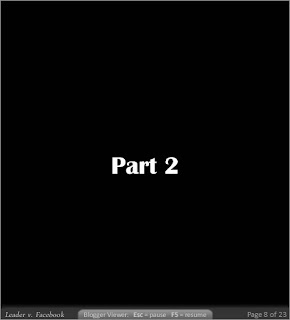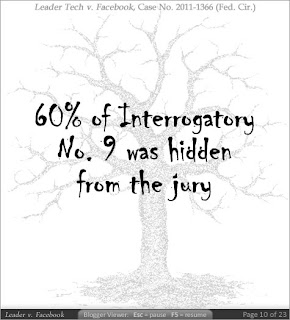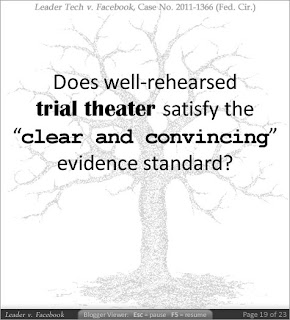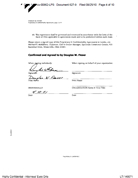OPINION: One blogger's perspective
Facebook concealed over 60% of Interrogatory No. 9; breached the completeness doctrine (Fed. R.Evid. 106)
January 15, 2012 – According to the trial court, Facebook’s lone trial victory for public disclosure/on sale bar in the
Leader v. Facebook patent infringement trial was founded on Interrogatory No. 9. The judge allowed Facebook to introduce this evidence over Leader’s objections and the Federal Rules of Evidence 106 (completeness). Here’s what the jury was given, contained in the jury binder sleight of hand:
Doc. No. 627-23;
Doc. No. 627-24;
See Facebook's jury binder innuendo;
See also Fig. 1 below.
Facebook's pleadings averaged 24 double-spaced lines per page. Counting the six Interrogatory No. 9 pages between the captions and the signatures, and not counting omitted pages, Facebook redacted 60% of the content.
Facebook's public disclosure/on sale bar argument turned on Interrogatory No. 9 as an alleged "inventor's admission" that the Leader2Leader technology in late 2002 contained the same technology as discussed in the interrogatory.
Opinion 45-55. An "interrogatory" is a pre-trial question put to a person who answers under oath. Facebook's attorney Michael Rhodes admitted that Facebook relied on this altered interrogatory as "a foundation for the on-sale issue."
Tr. PageID #: 10421:10-11.
 |
| Fig. 1 - Facebook concealed more than 60% of Interrogatory No. 9, which their Cooley Godward attorney Michael Rhodes admitted to the trial court was a "foundation" for their on sale bar argument. Professor Wigmore, an often-cited legal scholar, admonishes against allowing such doctored evidence. See John Henry Wigmore, Encyclopedia Britannica Online. This figure is an animated GIF (6MB). Interrogatory No. 9 is mocked up with textual greeking to approximate a complete interrogatory, consistent with other full interrogatories in evidence. Here are the doctored Interrogatories No. 9 as shown to the jury by Facebook: Doc. No. 627-23; Doc. No. 627-24. |
The trial court's allowance of this dramatically altered interrogatory is a clear breach of the Doctrine of Completeness (founded on the Federal Rules of Evidence
Rule 106). The problems associated with Facebook's concealment is best described by legal scholar Professor John H. Wigmore:
"Possibilities of error lie in trusting to a fragment of an utterance without knowing what the remainder was."
Wigmore, Evidence, 3rd ed.
(on the doctrine of completeness)
Facebook concealed more than 60% of the contents of Interrogatory No. 9 from the jury.
Facebook's version of Interrogatory No. 9 was the foundation of their on sale bar argument.
Remarkably, the foundation of Facebook's on sale bar argument is a single interrogatory in which over 60% of its content was concealed from the jury over Leader's objection. All of Facebook's other evidence keys off this interrogatory. Surely a fragmented interrogatory cannot survive the "heavy burden" of clear and convincing standard of proof.
The legal standard of "clear and convincing" evidence is required for Facebook to prove its case. Without it, Facebook cannot win legally.
Doc. No. 601 Final Jury Instructions, No. 4.7 ("clear and convincing evidence").
Facebook's "heavy burden" of "clear and convincing" evidence was affirmed recently by the US Supreme Court.
See Microsoft Corp. v. i4i Ltd. Partnership, 131 S. Ct. 2238 (Supreme Court 2011)
at 2247 ("a defendant raising an invalidity defense bore "a heavy burden of persuasion," requiring proof of the defense by clear and convincing evidence");
Id. at 2248 ("the burden of proving prior inventorship 'rests upon [the defendant], and every reasonable doubt should be resolved against him,' without tying that rule to the vagaries and manipulability of oral testimony . . . [a]nd, more than 60 years later, we applied that rule where the evidence in support of a prior-use defense included documentary proof—not just oral testimony").
Facebook concealed Leader’s written objections, thus stripping away the context for Interrogatory No. 9
The 2009 interrogatory asked what current Leader products and services practice (present tense) the invention. McKibben answered "Leader2Leader® powered by the Digital Leaderboard® engine is covered by the '761 Patent."
Doc. No. 627-23 (DTX 0963);
Doc. No. 627-24 (DTX 969). This question did not ask about Leader history, yet Facebook asserted at trial that Leader should have expanded the answer to include times past. However, Leader had no such burden. This assertion is akin to asking you what you are wearing, but then arguing that you should have expanded your answer to include everything you have ever worn.
More Facebook obfuscation
Facebook's counsel contradicted himself. He first asked the jury "He [McKibben] never showed you the product, did he? And he didn’t say it has this one or this one or this one." However, this implication of a burden shift contradicted his earlier statement that “my burden is higher."
Tr. PageID# 11510:20-22; 11528:9-16; 11497:5. Such contradictory arguments (that easily confuse a jury) are well-known obfuscation, sometimes called the "dark arts."
See Facebook’s' trial conduct;
Facebook's "court room theater";
Facebook's "I'm tired" tactic;
Missing Facebook Documents;
Facebook's jury binder innuendo;
Expert witness practices "dark arts".
“[C]ounsel's strategy consisted of efforts to obfuscate, cover-up, and subvert evidence.” Advanced Display Systems, Inc. v. Kent State University, 212 F. 3d 1272 (Fed. Cir. 2000) at 1288.
Misrepresented the legal standard. E-Pass Technologies, Inc. v. 3Com Corporation (Fed. Cir. 2009) at II.
“[D]eliberately obfuscated their claim.” Wright v. United States, 728 F. 2d 1459 (Fed. Cir. 1984) at 140.
Facebook's burden never shifted to Leader
The U.S. Supreme Court recently confirmed Facebook's "clear and convincing" burden of proof, citing 30 years of Federal Circuit precedent:
"[A] patent is valid and imposes the burden of proving invalidity on the attacker. That burden is constant and never changes and is to convince the court of invalidity by clear evidence."
"[A]n infringer who assails the validity of a patent fair upon its face bears a heavy burden of persuasion, and fails unless his evidence has more than a dubious preponderance" (emphasis added).
"[T]he burden of proving [on sale bar] invalidity [is] on the attacker [Facebook]. That burden is constant and never changes" citing Judge Rich, a principal drafter of the 1952 Patent Act (emphasis added).
Microsoft v. i4i at 2243, 2245; Supra.
Microsoft v. i4i and Leader v. Facebook have similar fact patterns
In
Microsoft v. i4i, Microsoft alleged that an i4i product with the brand name "S4" was sold more than 12 months before the priority date. i4i did not dispute that, but its two inventors testified that S4 did not contain the invention at that time. The testimony of the two inventors was all Microsoft had since the S4 source code had been destroyed years before. The jury ruled that Microsoft had not met its clear and convincing burden of proof to overcome the inventor's testimony.
In
Leader v. Facebook, Facebook alleged that a product with the brand name "Leader2Leader" was sold more than 12 months before the priority date. Leader did not dispute that, but its two inventors testified that Leader2Leader did not contain the invention at that time. Unlike i4i's absence of source code, Facebook was given access to the full Leader source code. Even so, Facebook did not present any of that source code at trial to support its on sale bar accusation. Instead, Facebook presented Interrogatory No. 9, and reinforced it with a smattering of emails and documents that mentioned the Leader2Leader brand name.
The
Microsoft v. i4i jury concluded that Microsoft had not met its burden of proof by merely showing that a product with the brand name "S4" had been sold. In other words, proof requires more than inferences and allegations.
The
Leader v. Facebook jury, on the other hand, decided that mere reference to a brand name "Leader2Leader" was sufficient inference proof that the brand must have contained the invention, even though Facebook presented no source code to prove it.
The fact patterns are similar in that both Microsoft and Facebook relied largely on the testimony of the two inventors in each case for their on sale bar evidence. Both Microsoft and Facebook argued that mere reference to a brand name was sufficient proof. Neither i4i nor Leader denied use of the
brand name more than 12 months before the critical date. Each of the two inventors for i4i and Leader testified that their respective brand names S4 and Leader2Leader did not embody their inventions more than 12 months before the critical date. Neither Microsoft or Facebook presented any source code evidence to prove their accusations. Both Microsoft and i4i were found to infringe.
What is glaringly different is the fact that while Microsoft had no i4i source code,
Facebook did have Leader's source code, but did not present any of it at trial.
What is also different is the outcome of the cases regarding on sale bar. The
Microsoft v. i4i jury ruled that Microsoft had failed to prove on sale bar by clear and convincing evidence. In other words, it found that mere references to brand names are not proof of the kind needed to meet the "heavy burden."
Surprising, with arguably stronger facts than i4i's (Facebook had Leader's source code), the
Leader v. Facebook jury ruled that Facebook had met its "clear and convincing" burden for on sale bar—even though they used only references to a brand name; effectively replicating Microsoft's no-hard-proof argument.
Reference to brand names are not proof of innovative source code
The main apparent difference between these cases, as was highlighted by the trial judge's Opinion, is this Interrogatory No. 9, and the smattering of "Leader2Leader" references in documents and emails ushered in behind it to reinforce the innuendo. Leader argues that brand name references are not the kinds of hard evidence required to meet Facebook's clear and convincing burden of proof. The
Microsoft v. i4i trial court, Federal Circuit, and now the US Supreme Court appear to agree with Leader that mere citing of brand names are not enough.
Facebook confused the jury with a self-styled "substantial" evidence standard instead of actual "clear and convincing" evidence
Facebook argues that its evidence is "substantial." However, substantial volume is not the criteria. That it might substantially support a dubious theory is also not the criteria. Indeed, Facebook's "evidence" merely supports their presumptions founded on Interrogatory No. 9--that the 2009 interrogatory admitted that the brand name Leader2Leader, for all time (and especially in 2002), embodied the invention. Leader's two inventors testified that it did not, and could not, because it was not ready. Without source code to prove otherwise, or at least very detailed engineering documents showing the Claim 1 tracking component, context component and storage component, nothing in evidence proves Facebook's theory. As a result, Facebook's "evidence" is nothing more than attorney trickery dressed up to look like evidence.
Was Facebook’s fragmented interrogatory dubious?
Facebook presented 60%-redacted Interrogatory No. 9 as a part of its jury binder hocus-pocus. The trial court overruled Leader's objection to its admissibility.
Tr. PageID #: 10421:7-8.
What was redacted? Facebook concealed Leader's many objections to the questions, and especially that they were vague and ambiguous. Hindsight says this objection was prophetic, given Facebook's subsequent effort to re-purpose the interrogatory. Leader also objected to use of the interrogatory outside the context of expert testimony. Tellingly, Facebook presented no expert testimony on the subject of public disclosure/on sale bar.
Even the trial court was ambiguous as to whether Facebook's evidence was "clear and convincing." The trial court wrote only that "there was evidence to support a finding."
Opinion 55. The law is clear that the mere existence of some evidence is not enough to support the
clear and convincing standard.
Evidence in legal proceedings is redacted when: (a) it is not relevant to the case, (b) protects someone’s privacy, or (c) is under a protective order. None of these reasons apply to the interrogatory. Instead, Facebook concealed Leader's objections to the interrogatory that would have allowed the jury to view the statements in their full context.
Again, Facebook's redactions beg the question about what was redacted and how did it prejudice Leader? Current news about Martin Luther King Jr. illustrates this point about the impact of redaction on meaning. MLK's family complains that a redacted quote on the Martin Luther King Jr. National Memorial makes him sound arrogant. While reasonable minds can disagree whether it does or doesn't, the family considered it an unacceptable truncation of a larger thought. MLK did not say he was a drum major, but was reflecting on that moniker if others considered it applicable to him.
Redacted MLK statement:
"I was a drum major for justice, peace and righteousness."
Original MLK statement:
“If you want to say I was a drum major, say I was a drum major for justice, peace and righteousness. ”
Clearly, context matters. Facebook concealed ALL of Leader's objections to the request, and without this full context for Interrogatory No. 9, common sense alone says that Facebook led the jury down a slippery slope.
Dubious evidence creates dubious conclusions
Without proper context, Facebook's 60%-redacted Interrogatory No. 9 is dubious. Such dubious evidence can only result in an equally dubious jury conclusion.
As a result, the "additional" evidence cited by the trial court in its footnote to support Facebook's obscured Interrogatory No. 9 are equally the fruit of a poisoned tree of evidence.
Opinion 55.
Facebook’s 60% redaction created a "false notion"
Professor Wigmore said:
"To look at a part [of an utterance] alone would be to obtain a false notion of the thought."
Wigmore, Evidence; United States v. Corrigan, 168 F. 2d 641 (1948) at 645 (emphasis added).
The dangers inherent in Facebook's concealment of the proper context are easily illustrated by use of Facebook’s own remaining words in the interrogatory as a hypothetical example.
Facebook asked about Leader products and services:
 |
| Fig. 2 - Facebook's unaltered Interrogatory No. 9. Facebook asks Leader about their products and services. Doc. No. 627-23. |
Or, did Facebook ask for a patent claim chart (redacted)?
 |
| Fig. 3 - Facebook's Interrogatory No. 9--REDACTED (to intentionally alter its context and meaning). This is now a request for a patent claim chart, and not for information about products and services. This simple example shows how redactions can be misleading. Doc. No. 627-23. |
In this example, Facebook asked in Fig. 2 for a statement about Leader’s products and services. However, the hypothetical Fig. 3 redaction appears to ask not about products and services, but about a patent claim chart. The hypothetical redaction in Fig. 3 makes the request
ambiguous. This simple example using all-Facebook words further illustrates the sagacity of Professor Wigmore’s admonition against tampering with evidence. The error in allowing Facebook's doctored version of Interrogatory No. 9 is evident.
Facebook breached the completeness doctrine by introducing a doctored Interrogatory No. 9
In overruling Leader's objection, the trial court prevented the jury from obtaining a full contextual view of Interrogatory No. 9, including Leader's many objections. The well-settled doctrine of completeness is intended to prevent just the sorts of prejudices suffered here.
"Rule 106. Remainder of or Related Writings or Recorded Statements. When a writing or recorded statement or part thereof is introduced by a party, an adverse party may require the introduction at that time of any other part or any other writing or recorded statement which ought in fairness to be considered contemporaneously with it." Federal Rules of Evidence Rule 106.
"[F]airness dictates that the balance be received so that the jury will not be misled." United States v. Rubin, 609 F. 2d 51 (1979) at 63.
"The rationale of the doctrine of completeness has been stated by Professor Wigmore: 'To look at a part [of an utterance] alone would be to obtain a false notion of the thought. * * * One part cannot be separated and taken by itself without doing injustice, by producing is representation'; and again, 'possibilities of error lie in trusting to a fragment of an utterance without knowing what the remainder was'; consideration of the whole is needed 'to avoid the danger of mistaking the effect of a fragment.' See Wigmore, Evidence, 3rd ed., §§ 2094, 2104, 2113, 2119, 2120." United States v. Corrigan, 168 F. 2d 641 (1948) at 645 (emphasis added).
The trial court's rationale in allowing Facebook to introduce a heavily-doctored (and so evidently prejudicial) Interrogatory No. 9 is baffling. Without Interrogatory No. 9, Facebook's on sale bar argument dies.
* * *

















![In re Bose Corp (Fed. Cir. 2009) 'There is no room for speculation, inference or surmise ... any doubt must be resolved against the charging party [Facebook]. In re Bose Corp (Fed. Cir. 2009) 'There is no room for speculation, inference or surmise ... any doubt must be resolved against the charging party [Facebook].](https://blogger.googleusercontent.com/img/b/R29vZ2xl/AVvXsEiOrME3L2KCdtRJSjcKavITJLZSgOi0c8OXFCTB5APE7Jf-smreeGVS9Ebnc_vTOXlRO3ogY54k_wZN8RuRyZ9_7-eaLv-EFl05MhU2vLiZCutGmXqQXjzDZABmdNDW0SjNyRzK0P5PxxM/s320/Leader-v-Facebook-NO-CLEAR-AND-CONVINCING-EVIDENCE-Slide-13-of-23.jpg)


![Slide 14 - Facebook offered no hard evidence. (1) No source code, (2) No element-by-element test, (3) No third party testimony, (4) No UCC commercial terms test, (5) No expert testimony, (6) No engineering records, (7) No programmer testimony, (8) No secrecy 'deeds' test, (9) No defenses for dispositive proofs: (9a) 'evaluation only' NDA clauses, (9b) registered trademark dates, (9c) experimental testing evidence, (9d) 'no legal effect' NDA clauses, (9e) no 'buyer/seller' relationships clause [WPAFB], (9f) 'no reliance' NDA clauses, (9g) 2009 present tense answer, and (9h) admission that source code was needed [Facebook's Cooley Godward attorney Mark Weinstein's statement to the judge six months before trial]. Slide 14 - Facebook offered no hard evidence. (1) No source code, (2) No element-by-element test, (3) No third party testimony, (4) No UCC commercial terms test, (5) No expert testimony, (6) No engineering records, (7) No programmer testimony, (8) No secrecy 'deeds' test, (9) No defenses for dispositive proofs: (9a) 'evaluation only' NDA clauses, (9b) registered trademark dates, (9c) experimental testing evidence, (9d) 'no legal effect' NDA clauses, (9e) no 'buyer/seller' relationships clause [WPAFB], (9f) 'no reliance' NDA clauses, (9g) 2009 present tense answer, and (9h) admission that source code was needed [Facebook's Cooley Godward attorney Mark Weinstein's statement to the judge six months before trial].](https://blogger.googleusercontent.com/img/b/R29vZ2xl/AVvXsEgbjiH8e7vfH35g_VFiGz0u3GRpB3fImN6j6zpsG3xM3T9LwADkyXSXHX8ED770aNWDc90GSk-p-7FoVfAowbAnOQZmpWhPCqzn60VAP9H-S1b4ujYt4xCVwDJ9WrXH0bzqrC4_nCGXvfA/s320/Leader-v-Facebook-NO-CLEAR-AND-CONVINCING-EVIDENCE-Slide-16-of-23.jpg)


















